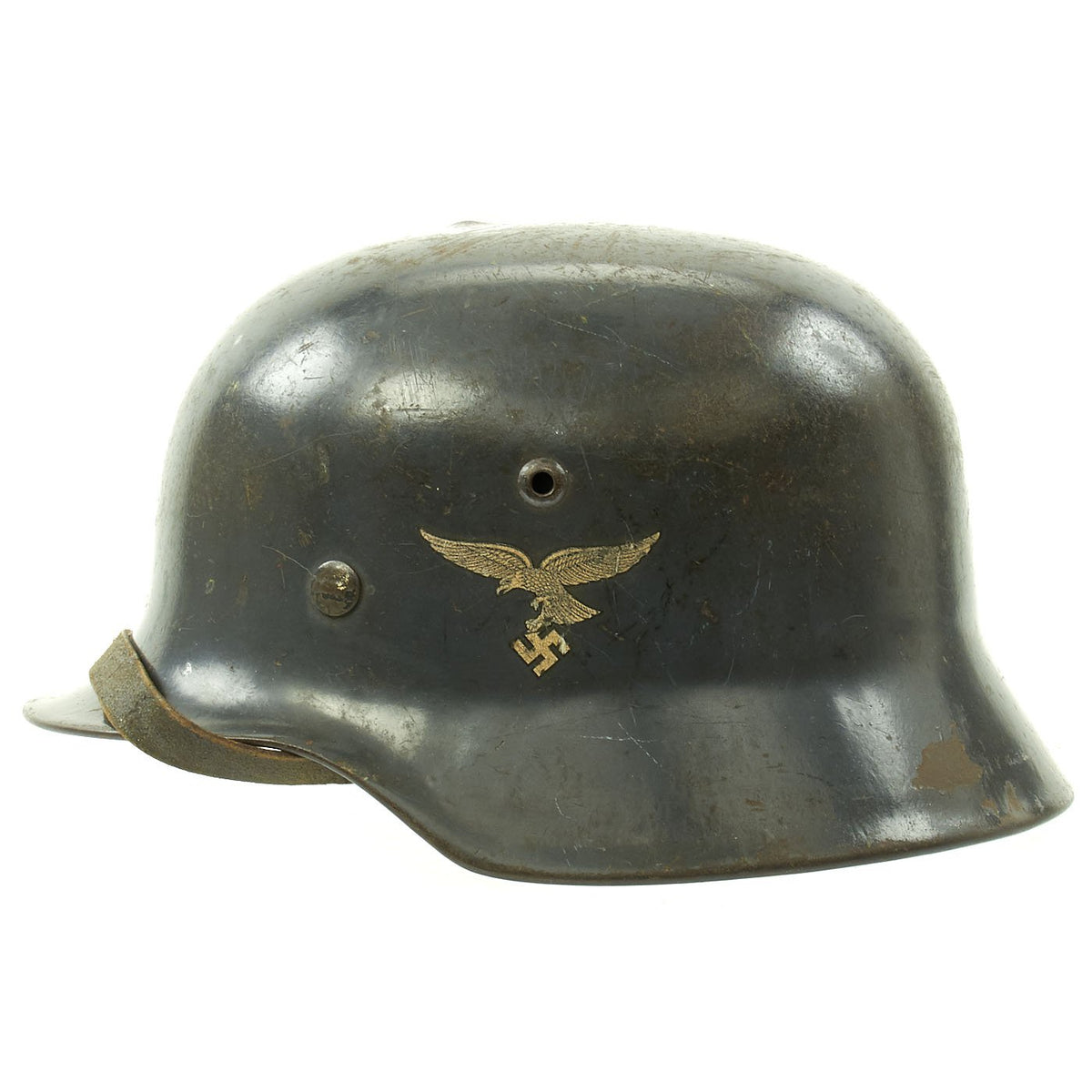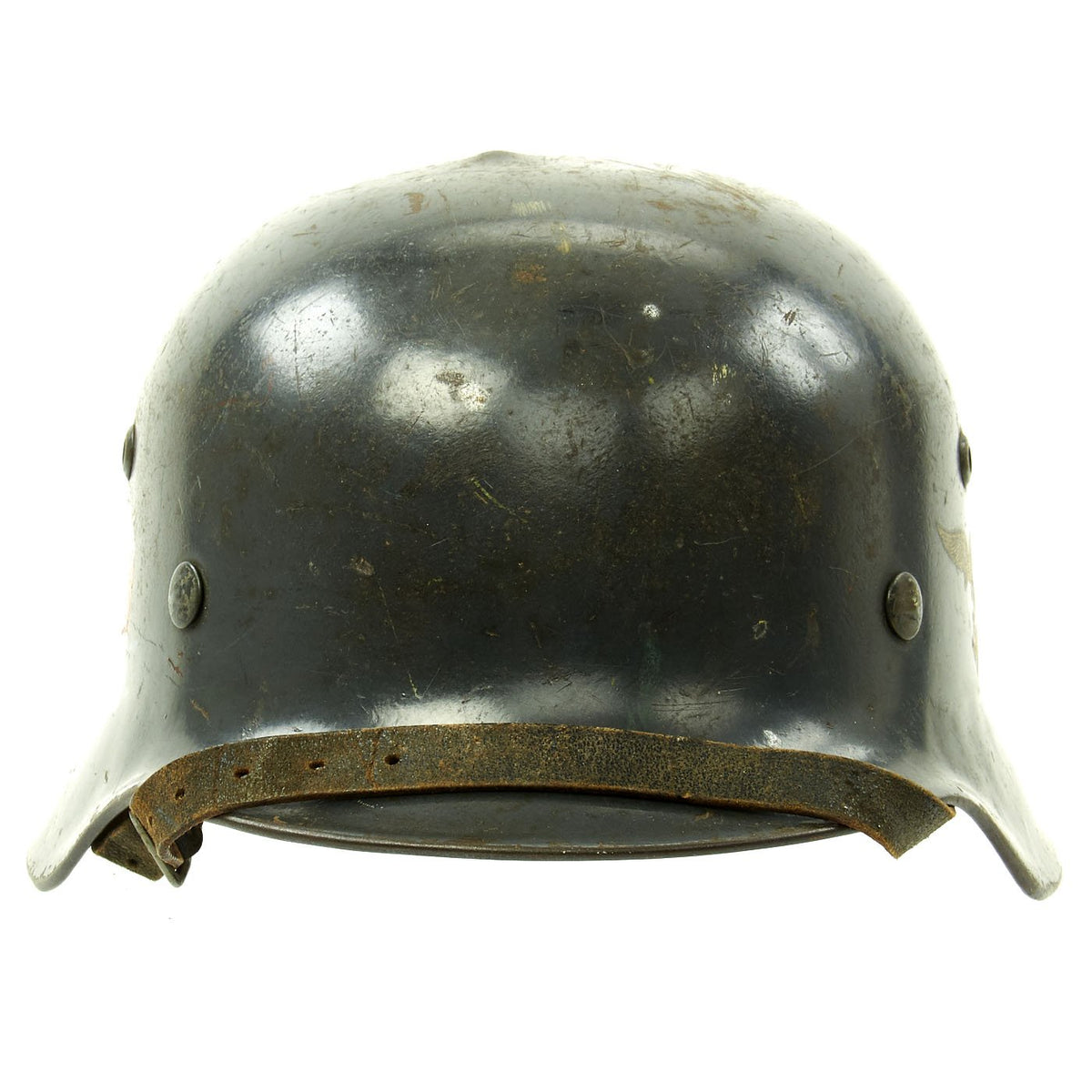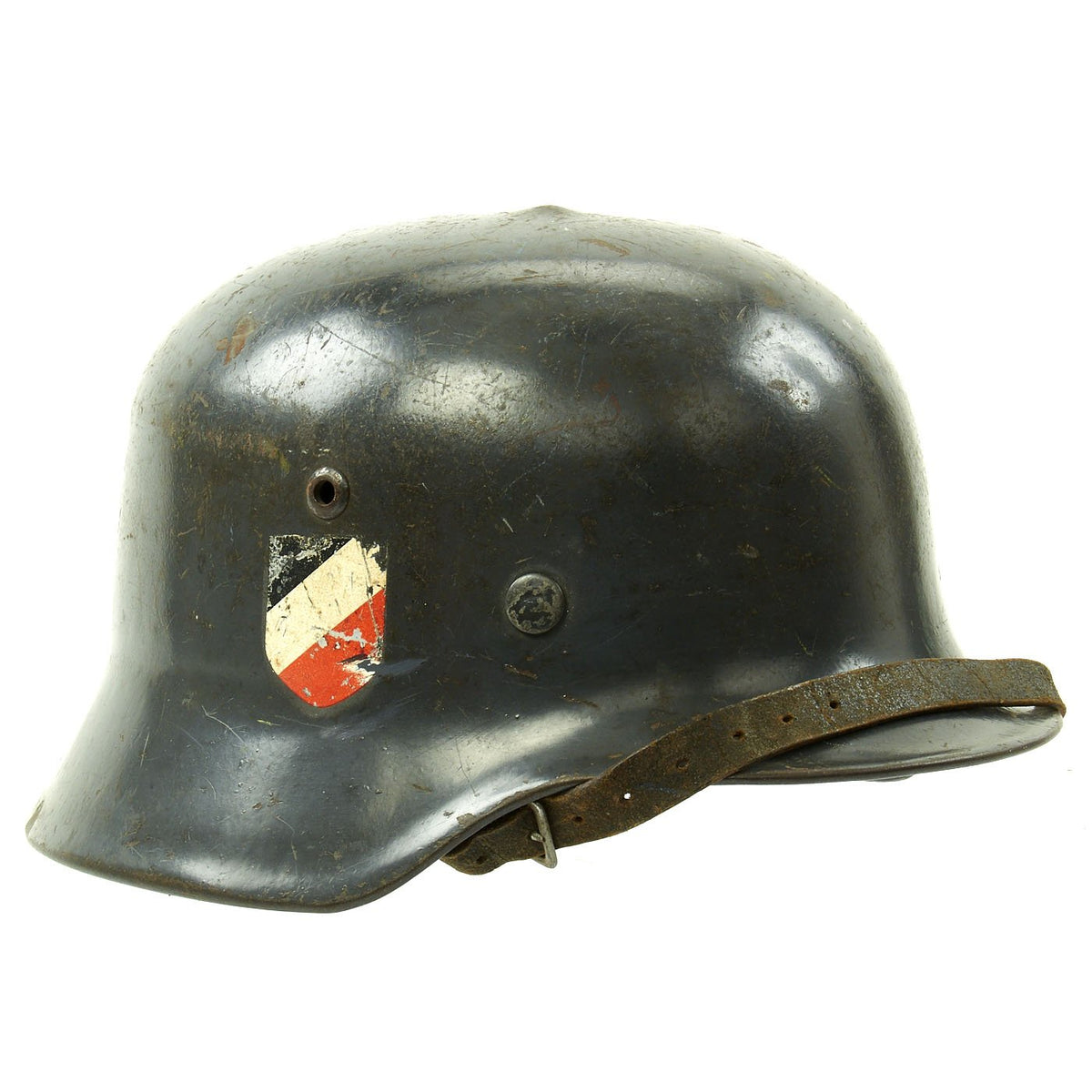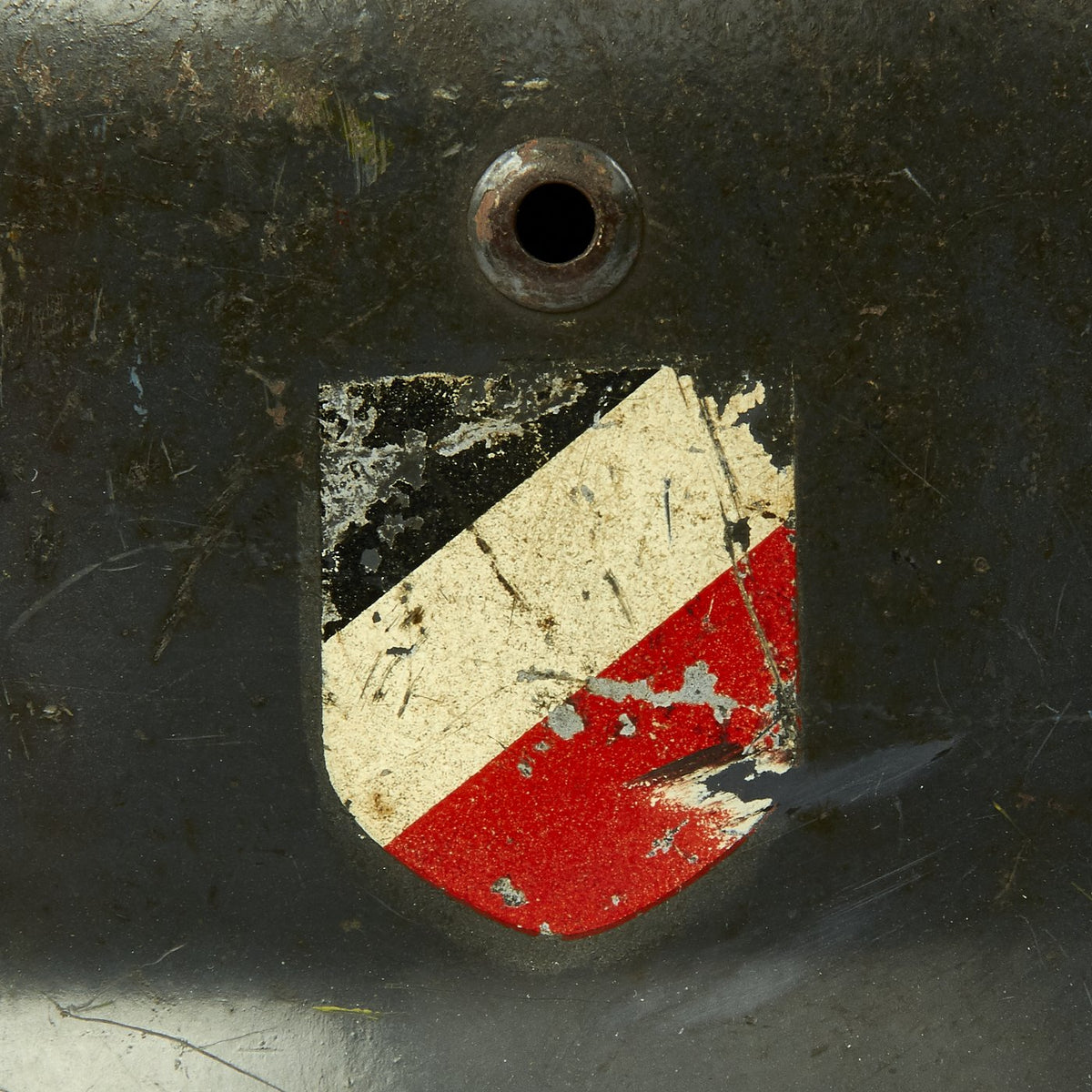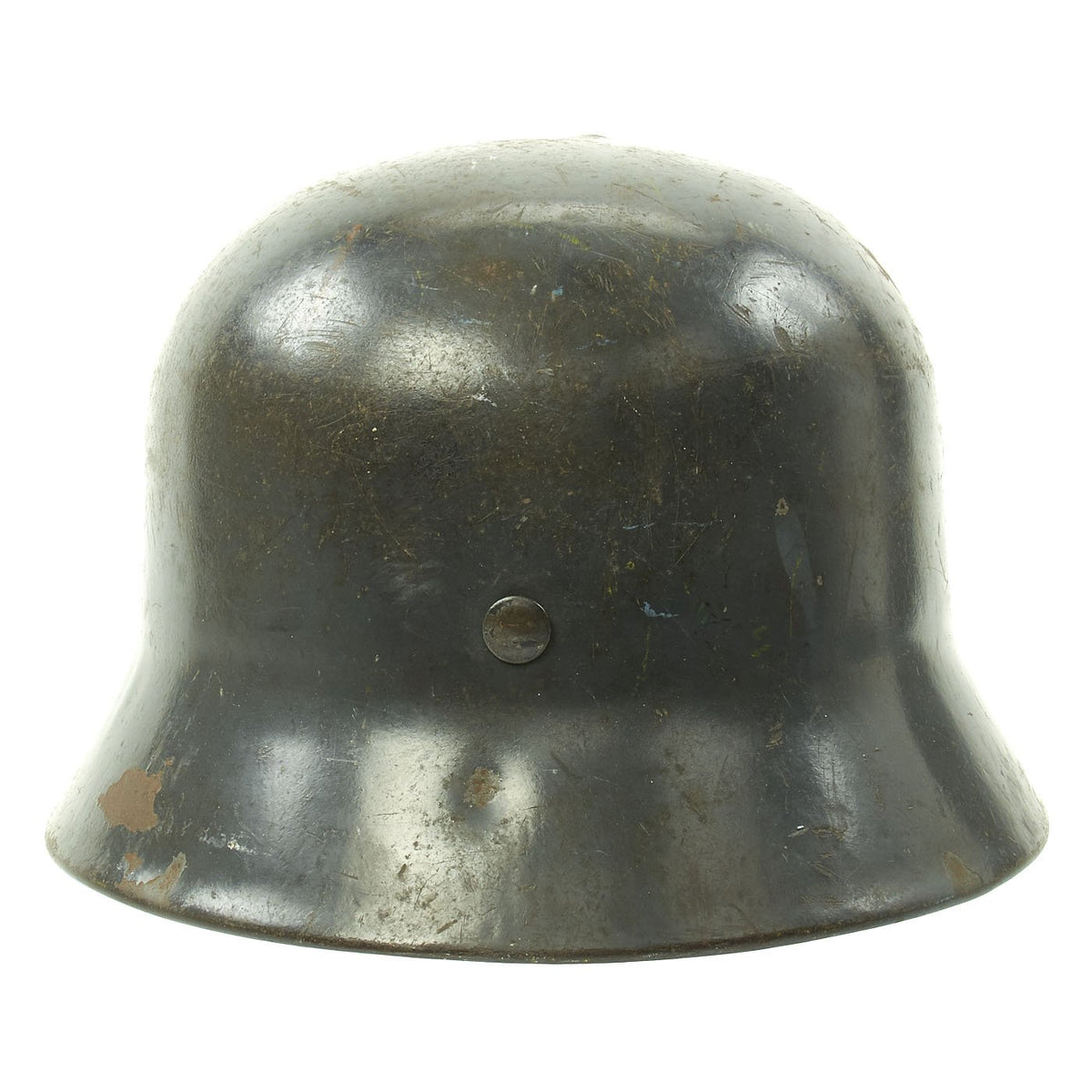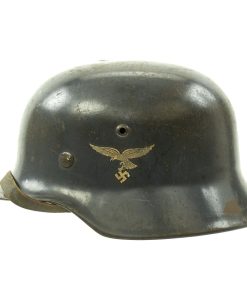Original German WWII Luftwaffe M35 Double Decal Droop Tail Eagle Steel Helmet with Flak Regt. Marking – Q64 Original Items
$ 1.895,00 $ 473,75
Original Item: Only One Available. This is an incredible all original example of a Model 1935 German WW2 “double decal” helmet, with an early “Droop-Tail” Luftwaffe Eagle decal on the left side, and a “National Colors” decal on the right. This stamped sheet steel construction helmet retains around 90% of the original Luftwaffe gray-blue paint and is in good condition overall, with just a few small dents, and no major damage. It also has a Luftwaffe Flak Artillery Regiment dome stamp inside the helmet!
The Luftwaffe decal is probably around 80%, one of the better droop-tails that we have seen. with overall age and checking. The National Colors decal fared a bit worse, with probably 70% remaining, mainly from some areas having been scratched off with the underlying paint. All three liner retaining pins are intact, with some of their original Luftwaffe blue paint.
The reverse, interior, neck guard apron is batch number stamped, 5169 and the interior, left side, apron has a stamped manufacturer’s code and size, Q64 indicating that indicating it was manufactured by Quist in Esslingen, Germany in size 64. Size 64 is a nice medium size that can accommodate liners from 56cm to 57cm or US 7 to 7 1/8. Size 66 shells are harder to find and are therefore more valuable to a collector.
This helmet has regiment markings ink stamped on the inside, which appear to read:
L / Flak – Regt. 68
This would be for Luftwaffe Flak Regiment 68. There is also a 1/B marking, for either the battalion or possibly the battery it was issued to.
The helmet still has its correct good condition M31 liner, with all 8 fingers intact and flexible. The leather is a bit stiff due to age, but does not show major wear, and the original top tie string is intact. The liner band is the correct early war aluminum, correct for a helmet of this vintage, and is marked 64 / 56, indicating that it is a size 56 for a size 64 shell. It also has the full maker marking on the right side:
BERL. KOFFERFABRIK
INH. MAX DENSOW
1936
The Max Densow firm only made these very early pre-war examples, and had stopped production of helmet liners by the start of the war. This makes this a very rare and highly desirable liner. The chinstrap is intact, and still soft, though it appears to have been replaced during the helmet’s service life, as it has galvanized steel buckles, and is dated 1941.
Overall a very nice totally correct 100% genuine very early double decal Luftwaffe helmet, marked to a Flak Regiment! Ready to display!
The first “modern” steel helmets were introduced by the French army in early 1915 and were shortly followed by the British army later that year. With plans on the drawing board, experimental helmets in the field, (“Gaede” helmet), and some captured French and British helmets the German army began tests for their own steel helmet at the Kummersdorf Proving Grounds in November, and in the field in December 1915. An acceptable pattern was developed and approved and production began at Eisen-und Hüttenwerke, AG Thale/Harz, (Iron and Foundry Works), in the spring of 1916.
These first modern M16 helmets evolved into the M18 helmets by the end of WWI. The M16 and M18 helmets remained in usage through-out the Weimar Reichswehr, (National Defence Force, Circa 1919-1933), era and on into the early years of the Third Reich until the development of the smaller, lighter M35 style helmet in June 1935.
The Luftwaffe pattern national eagle was originally introduced for wear by Fliegerschaft, (Pilot Base), personnel of the DLV, Deutscher Luftsportsverband, (German Air Sports Association), the clandestine, civilian, forerunner of the Luftwaffe on August 18TH 1934, and adopted for wear by the Luftwaffe on March 1ST 1935 along with the national tri-color shield for wear on the helmet.
The first pattern national eagle was utilized until a modified second pattern eagle was introduced in late 1936 or early 1937. Regulations of June 12TH 1940 discontinued the use of the national tri-color decal and further regulations of August 28TH 1943 abolished the national eagle decal and dictated that it was also to be removed from all helmets although the directives were not completely adhered to.
Fast Shipping with Professional Packaging
Thanks to our longstanding association with UPS FedEx DHL, and other major international carriers, we are able to provide a range of shipping options. Our warehouse staff is expertly trained and will wrap your products according to our exact and precise specifications. Prior to shipping, your goods will be thoroughly examined and securely secured. We ship to thousands clients each day across multiple countries. This shows how we're dedicated to be the largest retailer on the internet. Warehouses and distribution centres can be located throughout Europe as well as the USA.
Note: Orders with more than one item will be assigned a processing date depending on the item.
Before shipping before shipping, we'll conduct a thorough inspection of the items you have ordered. Today, the majority of orders will be delivered within 48 hours. The delivery time will be between 3-7 days.
Returns
The stock is dynamic and we cannot completely manage it because multiple stakeholders are involved, including our factory and warehouse. So the actual stock may alter at any time. It's possible that you may not receive your order once the order has been made.
Our policy is valid for a period of 30 days. If you don't receive the product within 30 days, we are not able to issue a refund or an exchange.
You can only return an item if it is unused and in the same state as the day you received it. You must have the item in its original packaging.
Related products
Uncategorized
Uncategorized
Uncategorized
Uncategorized
Uncategorized
Uncategorized
Australian WWII Owen MK1 Machine Carbine SMG Custom Fabricated Replica with Sling Original Items
Uncategorized
Uncategorized
Uncategorized
Angolan Rebel 1970s era 60mm Inert Display Mortar from Angolan Civil War Original Items
Uncategorized
Armored Burgonet Helmet & Polearm from Scottish Castle Leith Hall Circa 1700 Original Items
Uncategorized
Uncategorized
Uncategorized
Uncategorized
Uncategorized
Uncategorized
Band of Brothers ORIGINAL GERMAN WWII Le. F.H. 18 10.5cm ARTILLERY PIECE Original Items
Uncategorized
Uncategorized
Uncategorized
Uncategorized
